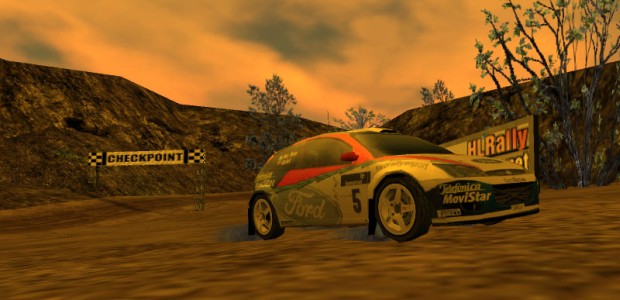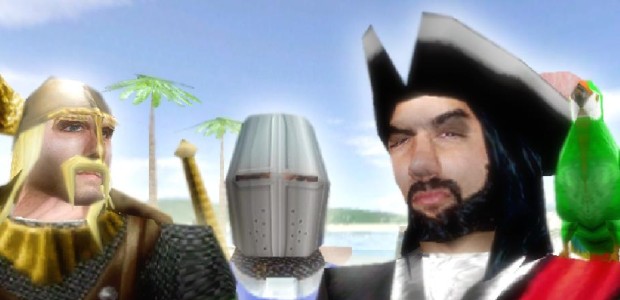Total Converts: Unpotting The History Of Half-Life Modding
In Defense Of Being Shit
Total Converts is a new weekly column about mods, maps, models, and anything player-created which you can use to amend or append your games.
Modding used to suck.
Back in 1999, I became hooked on Half-Life. Hooked in the way only 14-year-olds can, with a pure, uncritical love. The problem I had - familiar to many today - was that Half-Life was finite and I had no idea if more would ever be made.
So in between rounds of laggy, 56k deathmatch with a friend, I turned to mods, custom maps, and anything else I could find which would allow me to wring more from my investment in Black Mesa. I hung out in IRC rooms, read map review sites and slowly downloaded files from Fileplanet. It felt like I was crawling through obscure corners of the internet, at a time when the internet seemed to inhabit a strange corner of the real world.
Imagine my surprise when I walked into a gift ship while on holiday in an English seaside town and found the CD pictured above. A collection of Half-Life add-ons for sale in the most ordinary place.
Even then, with my limited understanding of game development and zero understanding of intellectual property, I knew something was off about it. I'd spent enough time buying pirated Amiga 500 games from the Glasgow Barras to recognise a knockoff.
I bought it anyway (and it turns out you can now download the whole collection from ModDB). In retrospect there are some pretty clear signs that it wasn't an official release. The text on the back of the jewel case begins, "A complete collection of addons for half life including single player levels, Death match levels, Team fortress classic levels, new config files, a superb collection of new skins/models, editors and much, much, more." After a long list of file names, it ends, "A must for any Half Life fan unleash the Power of Half Life!."
The contents are similarly muddled. There are the character models bragged about on the back, including Homer Simpson and Alian (from the movie Alian). There's a selection of maps, both single and multiplayer. There are mods, including beta 1 of Counter-Strike. But there's also a stranger set of materials, including a WinAmp skin, some screensavers, and editing tools for, er, Unreal games.
The CD still works, though many of its contents wouldn't be compatible with the Steam version of the game. What does work are the maps, which are mostly mediocre examples of the creativity that made the Half-Life community so vibrant. It's a little like stumbling upon someone's fanart Tumblr; that discomforting feeling when someone's enthusiasm outstrips their talent. There's nothing so awkward as sincerity.
So why have I kept the CD these past 14 years, while throwing out the majority of my physical game collection?
When we talk about Half-Life and its mods today, we tend to condense the story down to a few better remembered releases like Counter-Strike, Day of Defeat and Natural Selection. But there was a lot more to it, and that vibrant Half-Life community kept me entertained for years.
There were so many mods doing interesting things. Sven Co-Op was a bawdy mess, but its conversion of singleplayer maps to co-op multiplayer felt in some ways miraculous.
Half-Life Rally never felt complete and was following in the tire tracks of what Quake Rally accomplished years earlier, but its eye for detail and the scale of its tracks opened up Goldsource in ways that previously seemed impossible.
Action Half-Life, The Opera and The Specialists all found ways to make multiplayer fights more stylish. There were dozens that made them sillier, sometimes with simple ideas like the Snark Mod's array of weapons based on the small, carnivorous roaches. Pirates, Vikings & Knights had a launchable parrot attack.
There were even more single player mods that made worthwhile contributions. Neil Manke used mostly existing Half-Life assets to create a believable spaceship in USS Darkstar and a thick, pre-Ravenholm horror atmosphere in They Hunger. Dave Johnston (creator of de_dust) made ETC (and its sequel). Adam Foster, before he made Minerva and got a job at Valve, made the Xen-redeeming Someplace Else. My favourite remains Chris Spain's Edge of Darkness.
I can keep going, but even while stepping beyond the obvious, I'm still telling the story of the winners. In reality the mod community was full of things you would never want to play, made by teenagers who dabbled, gave up and moved on. Most modders and mappers did not make works which expanded our idea of what was possible with the Half-Life engine, or chart new ground which would later become commercial releases. Most people made novelty maps full of point lighting and terrible r_speeds.
But this is why I love mods. Those people whose enthusiasm outstripped their talent? I'm one of them.
After having played so many, I came to the conclusion that I must be able to make a map of my own. I released just one, a 2-4 player deathmatch map in which I stubbornly refused to accept Half-Life didn't have Quake 3's jump pads, and set its floors so far apart you couldn't get down without breaking your legs. It was awful. I would link it here, but I honestly can't remember its name.
Mostly I just built and re-built and built again a single corridor. I have screenshots of that.
I learned a lot and accomplished nothing. It was fun. It was a way to bask in my obsession with Half-Life during the six years it took for Half-Life 2 to come out. It was free. It was constructive. It led, via reviewing Half-Life maps and interviewing modders for fan sites, to my entire career. Modding made me. There's nothing so awkward as sincerity.
I kept the CD because it's a reminder that modding communities are more than the sum of their famous works. This is a kind of mission statement for this column. Sometimes I'll do that thing - that Top X Mods For Game Y thing, because there's nothing wrong with it. Sometimes I will speak to people who quote-unquote made it by turning professional.
But while mods' function as a source of practice and experience is certainly useful, these communities aren't just birthing farms for future weapon modellers. They don't become relevant at the point at which they're touched by the shrivelled claw of commercial credibility. They are relevant and exciting and fascinating at the moment a person loves something so much they decide to risk embarrassment in order to find out how it works so they can spend more time with it.
Modding used to suck. I hope it still does.
Next week: something you might want to go play. Although really you should be checking checking out ETS2 or Someplace Else or Edge of Darkness for Half-Life 1 right now.





